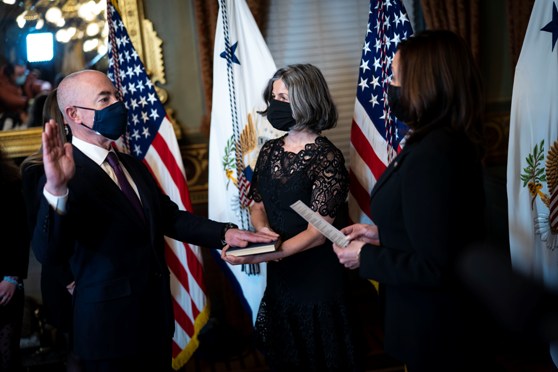Biden issues orders to dismantle Trump’s ‘America First’ immigration agenda

By Michael D. Shear and Zolan Kanno Youngs
WASHINGTON — President Joe Biden moved cautiously on Tuesday (2) to confront the most intractable immigration issues that his predecessor left behind: reuniting migrant children separated from their families, rebuilding a working asylum system and restoring opportunities for foreign workers and students to enter the country.
As a candidate, Biden vowed to once again welcome immigrants to American shores by quickly rolling back hundreds of actions by President Donald Trump that were aimed at deporting immigrants and shutting the country off from those seeking work or refuge.
A trio of executive orders signed Tuesday reflect a reimagining of America’s place in the world after four years of Trump’s ‘America First’ vision. But administration officials and immigration advocates cautioned that will not happen immediately. Biden’s government is wary of flinging open the border until it has rebuilt an asylum and refugee system that can process potentially large influxes of people.
With thousands of migrants already living in squalor on the Mexican side of the border, a crisis could develop quickly, and that would be a nightmare for the new president this early in his term. And the effort to locate parents and children separated in the summer of 2018 will take months, if not years.
“We’re going to work to undo the moral and national shame of the previous administration that literally, not figuratively, ripped children from the arms of their families, the mothers and fathers at the border, and with no plan — none whatsoever — to reunify the children,” Biden said as he signed the orders in the Oval Office.
Biden said the orders would also begin to address “the root causes” of migration toward the southern border and begin a “full review of the previous administration’s harmful and counterproductive immigration policies.”
“There’s a lot of talk, with good reason, about the number of executive orders that I have signed,” he added. “I’m not making new law. I’m eliminating bad policy.”
Biden’s actions came just hours after the Senate confirmed Alejandro N. Mayorkas as secretary of Homeland Security, with all but seven Republicans voting no in a show of their opposition to Biden’s immigration agenda. The vote underscored the deep divide that persists in Washington about how the country treats foreigners.
Shortly after the president signed the orders, Vice President Kamala Harris swore Mayorkas into office, making him the first Latino and the first immigrant to hold that job, which has been vacant for around 21 months.
Conservative activists lashed out at Biden’s executive orders and the confirmation of Mayorkas, saying the president was pursuing a policy that would undermine border security and cost Americans jobs.
“By abandoning common-sense asylum policies and increasing the burden on our strained social safety net, these orders will take away jobs from Americans struggling to find employment,” said Jessica Anderson, the executive director of Heritage Action.
But the orders do little more in the short term than order government evaluations. Two of them order a review of Trump’s immigration policies that limited asylum, stopped funding to foreign countries, made it more difficult to get green cards or be naturalized, and slowed down legal immigration into the United States. The third establishes a task force, headed by Mayorkas, to identify families separated at the border.
For the most part, the orders do not immediately reverse Trump’s policies. One order did direct the Homeland Security secretary to “promptly cease” two programs established last year that put migrants on a fast track to deportation.
The reviews and the task force could ultimately open new channels of legal immigration, expand the chance that migrants fleeing violence can win asylum, end the Trump program that forces migrants to wait in Mexico and fully repair the damage done by Trump’s “zero tolerance” policy that led to family separations at the border.
But Biden’s top spokeswoman said Tuesday that it will take time.
“Part of our effort,” said Jen Psaki, the White House press secretary “is to assess the damage that’s been done by the policies that were put in place by the prior administration. We want to act swiftly, we want to act promptly, but we also need to make sure we’re doing that through a strategic policy process.”
As an example, she said the new task force charged with reuniting children separated at the border from their parents will not make an initial report to Biden for four months — adding to a more than two-year wait for some families.
“While these announcements are welcome and transformative news, the humanitarian crisis has not changed at the border,” said Alida Garcia, the vice president for advocacy at FWD.us, a business-focused immigration group. “There is a tremendous amount of urgent work to fix a long-failed immigration system.”
Frank Sharry, executive director of America’s Voice, a pro-immigration advocacy group, said that “unwinding the cruelty and chaos and building a fair, humane and functional asylum and immigration system will take time.”
But Lee Gelernt, an American Civil Liberties Union lawyer who waged a long legal battle against Trump’s separation policy, said Biden must move quickly.
“What we need now is an immediate commitment to specific remedies, including reunification in the US, permanent legal status and restitution for all of the 5,500-plus families separated by the Trump administration,” Gelernt said. “Anything short of that will be extremely troubling given that the US government engaged in deliberate child abuse.”
Biden campaigned on a border policy that would rely less on detaining migrants and more on programs that track them after they are released into the United States to ensure that they show up for immigration court. But he had already warned in December that rolling back all of the Trump administration’s policies would most likely take “the next six months,” partially in an effort to avoid a rush to the border.
-New York Times

